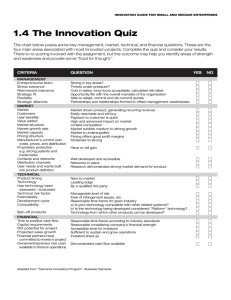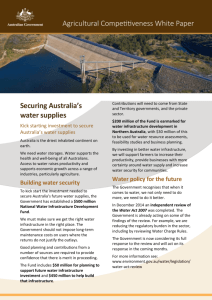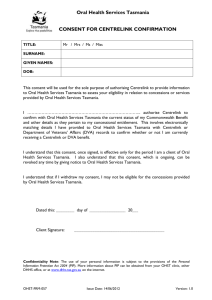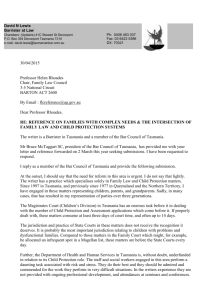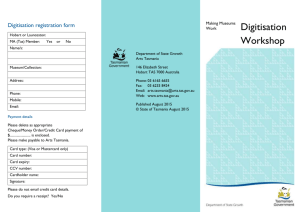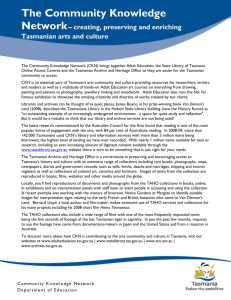Tasmania is a State in the Australian federation. Its relationship with
advertisement
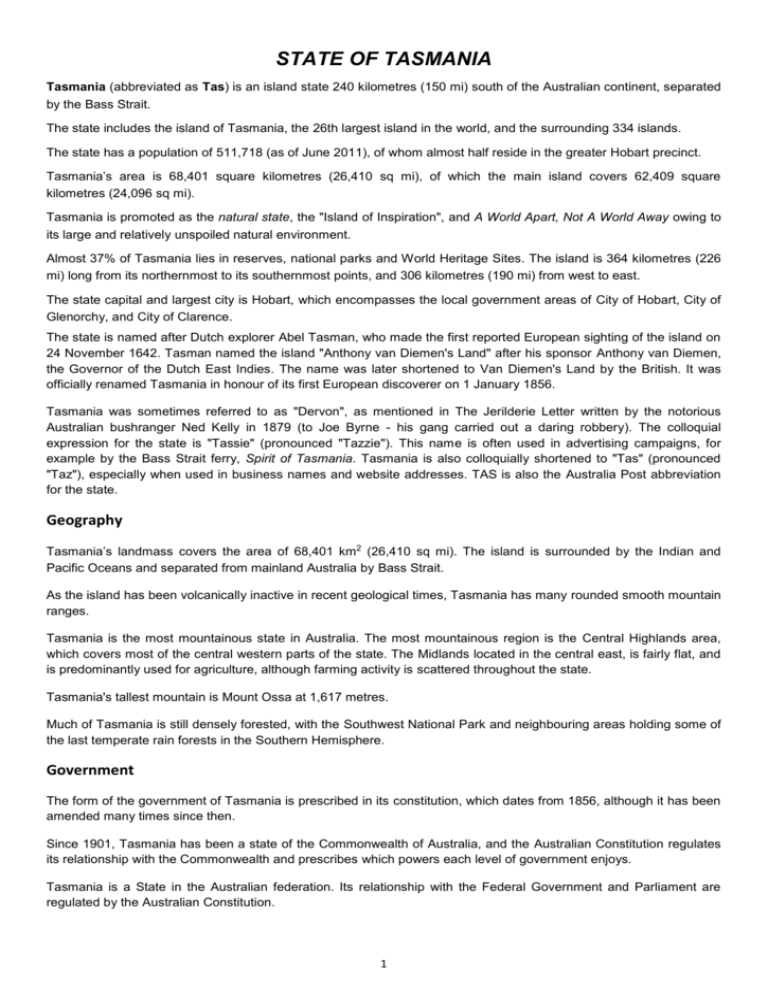
STATE OF TASMANIA Tasmania (abbreviated as Tas) is an island state 240 kilometres (150 mi) south of the Australian continent, separated by the Bass Strait. The state includes the island of Tasmania, the 26th largest island in the world, and the surrounding 334 islands. The state has a population of 511,718 (as of June 2011), of whom almost half reside in the greater Hobart precinct. Tasmania’s area is 68,401 square kilometres (26,410 sq mi), of which the main island covers 62,409 square kilometres (24,096 sq mi). Tasmania is promoted as the natural state, the "Island of Inspiration", and A World Apart, Not A World Away owing to its large and relatively unspoiled natural environment. Almost 37% of Tasmania lies in reserves, national parks and World Heritage Sites. The island is 364 kilometres (226 mi) long from its northernmost to its southernmost points, and 306 kilometres (190 mi) from west to east. The state capital and largest city is Hobart, which encompasses the local government areas of City of Hobart, City of Glenorchy, and City of Clarence. The state is named after Dutch explorer Abel Tasman, who made the first reported European sighting of the island on 24 November 1642. Tasman named the island "Anthony van Diemen's Land" after his sponsor Anthony van Diemen, the Governor of the Dutch East Indies. The name was later shortened to Van Diemen's Land by the British. It was officially renamed Tasmania in honour of its first European discoverer on 1 January 1856. Tasmania was sometimes referred to as "Dervon", as mentioned in The Jerilderie Letter written by the notorious Australian bushranger Ned Kelly in 1879 (to Joe Byrne - his gang carried out a daring robbery). The colloquial expression for the state is "Tassie" (pronounced "Tazzie"). This name is often used in advertising campaigns, for example by the Bass Strait ferry, Spirit of Tasmania. Tasmania is also colloquially shortened to "Tas" (pronounced "Taz"), especially when used in business names and website addresses. TAS is also the Australia Post abbreviation for the state. Geography Tasmania’s landmass covers the area of 68,401 km2 (26,410 sq mi). The island is surrounded by the Indian and Pacific Oceans and separated from mainland Australia by Bass Strait. As the island has been volcanically inactive in recent geological times, Tasmania has many rounded smooth mountain ranges. Tasmania is the most mountainous state in Australia. The most mountainous region is the Central Highlands area, which covers most of the central western parts of the state. The Midlands located in the central east, is fairly flat, and is predominantly used for agriculture, although farming activity is scattered throughout the state. Tasmania's tallest mountain is Mount Ossa at 1,617 metres. Much of Tasmania is still densely forested, with the Southwest National Park and neighbouring areas holding some of the last temperate rain forests in the Southern Hemisphere. Government The form of the government of Tasmania is prescribed in its constitution, which dates from 1856, although it has been amended many times since then. Since 1901, Tasmania has been a state of the Commonwealth of Australia, and the Australian Constitution regulates its relationship with the Commonwealth and prescribes which powers each level of government enjoys. Tasmania is a State in the Australian federation. Its relationship with the Federal Government and Parliament are regulated by the Australian Constitution. 1 Tasmania is represented in the Senate by 12 senators, on an equal basis with all other states. In the House of Representatives, Tasmania is entitled to five seats. Local government Tasmania is divided into 29 Local Government Areas. Local councils are responsible for functions delegated by the Tasmanian parliament, such as urban planning, road infrastructure and waste management. Council revenue comes mostly from property taxes and government grants. As with the House of Assembly, Tasmania's local government elections use a system of multi-seat proportional representation known as Hare-Clark. The single transferable vote (STV) is a voting system designed to achieve proportional representation through ranked voting. Under STV, an elector's vote is initially allocated to his or her most preferred candidate, and then, after candidates have been either elected or eliminated, any surplus or unused votes are transferred according to the voter's stated preferences. A modified version of STV, known as the Hare–Clark system. The name is derived from Thomas Hare, who initially developed the system and the Tasmanian Attorney General, Andrew Inglis Clark, who worked to have a modified version introduced Система единого непереходного голоса — это избирательная система, основанная на пропорциональном представительстве и преференциальном выборе избирателя. В случае использования системы единого непереходного голоса, голос избирателя изначально поданный за наиболее предпочтительного кандидата, затем после того, как кандидаты были избраны или исключены, оставшиеся «лишние» или неиспользованные голоса перераспределяются согласно наибольшим предпочтениям избирателей. Система минимизирует потери голосов, которые следуют исходя из особенностей пропорциональной избирательной системы, и предоставляет возможность оценки кандидатов в большей степени, нежели это предполагают закрытые партийные списки. Indigenous people Tasmania was first inhabited by the Tasmanian Aborigines. Evidence indicates their presence in the region, later to become an island, at least 35,000 years ago. Rising sea levels cut Tasmania off from mainland Australia about 10,000 years ago. By the time of European contact, the Aboriginal people in Tasmania had nine major ethnic groups. At the time of British settlement in 1803, the indigenous population was estimated at between 5,000 and 10,000 people. Through the introduction of infectious diseases to which they had no immunity, war, persecution, and intermarriage,[14] the population dwindled to 300 by 1833. Almost all of the indigenous population was relocated to Flinders Island by George Augustus Robinson. A woman named Truganini (1812–76) is generally recognised as the last full-blooded Tasmanian Aborigine. Strong evidence suggests that the last survivor was another woman, Fanny Cochrane Smith, who was born at Wybalena and died in 1905. Economy Tasmania's erratic economy was first experienced by colonists in the early 19th century. The reasons have been many and varied over the years. Lack of a federal infrastructure highway, lack of a gold rush, lack of open immigration initiatives, lack of population, decline in the wool and mineral economies, lack of early colonial initiatives, or lack of foreign investment have all been attributed as reasons for the erraticism of the economy. For the length of colonial history of Tasmania, a continuing exodus of youth to mainland Australia to seek employment opportunities has occurred. Traditionally, Tasmania's main industries have been mining (including copper, zinc, tin, and iron), agriculture, forestry, and tourism. In the 1940s and 1950s, a hydro-industrialisation initiative was embodied in the state by Hydro Tasmania. These all have had varying fortunes over the last century and more, involved in ebbs and flows of population moving in and away dependent upon the specific requirements of the dominant industries of the time. The state also has a large number of food exporting sectors, including but not limited to seafood (such as Atlantic salmon, abalone and crayfish). 2 In the 1960s and 1970s there was a rapid decline in traditional crops such as apples and pears, with other crops and industries eventually rising in their place. During the 15 years until 2010, new agricultural produces such as wine, saffron, pyrethrum and cherrieshave been fostered by the Tasmanian Institute of Agricultural Research. Manufacturing declined during the 1990s, leading to a drain of some of the island's trained and experienced working population to mainland Australia, especially to urban centres such as Melbourne and Sydney. Since 2001, however, the Tasmanian economy has experienced a significant improvement. Favourable economic conditions throughout Australia, cheaper air fares, and two new Spirit of Tasmania ferries have all contributed to what is now a booming tourism industry. About 1.7% of the Tasmanian population are employed by local governments. Other major employers include the Federal Group, owner of several hotels and Tasmania's two casinos, and Gunns Limited, the state's biggest forestry company. Small business is a large part of the community life, including such success stories as International Catamarans, Moorilla Estate and Tassal. In the late 1990s, many national companies based their call centres in the state after obtaining cheap access to broad-band fibre optic connections. Apparently the state's housing market was undervalued in the early part of 2000, and a large boom in the national housing market finally made Tasmanian housing prices rise dramatically. This has in part been attributed to increased levels of interstate and overseas immigration. A shortage of rental accommodation has caused problems for many of Tasmania's low income earners. Thirty-four percent of Tasmanians are reliant on welfare payments as their primary source of income. This number is in part due to the large number of older residents and retirees in Tasmania receiving Age Pensions. Flora and fauna of Tasmania Geographically and genetically isolated, Tasmania is known for its unique flora and fauna. Tasmania has extremely diverse vegetation, from the heavily grazed grassland of the dry Midlands to the tall evergreen eucalypt forest, alpine heathlands and large areas of cooltemperate rainforests and moorlands in the rest of the state. Many flora species are unique to Tasmania, and some are related to species in South America and New Zealand through ancestors which grew on the super continent of Gondwana, 50 million years ago. The island of Tasmania was home to the Thylacine, a marsupial which resembled a wild dog. Known colloquially as the Tasmanian Tiger for the distinctive striping across its back, it became extinct in mainland Australia much earlier because of competition by the dingo, introduced in prehistoric times. Owing to persecution by farmers, government-funded bounty hunters and, in the final years, collectors for overseas museums, it appears to have been exterminated in Tasmania. The Tasmanian devil became the largest carnivorous marsupial in the world following the extinction of the thylacine in 1936, and is now found in the wild only in Tasmania. The Tasmanian blue gum, Eucalyptus glololus Labill, is Tasmania's floral emblem. The Tasmanian blue gum flowers, larger than those of other Tasmanian eucalypts, usually occur singly in the axils of the leaves. Up to three quarters of an inch in diameter, Found throughout the Australian island state of Tasmania, including the historic Royal Hobart Botanical Gardens, the Tasmanian blue gum grows largely in southern and eastern Tasmania and in the middle reaches of the Derwent River. It can grow up to 60 metres (approximately 200 feet). Introduced overseas, it can be found in California in the United States, in the Mediterranean region and parts of Africa and India, and in Chile, Argentina and New Zealand. Hobart Founded in 1804 as a penal colony. Hobart is Australia's second oldest capital city after Sydney, New South Wales. In 2011, the city had a greater area population of approximately 211,656. A resident of Hobart is known as a "Hobartian". The city is located in the state's south-east on the estuary of the Derwent River. The city is the financial and administrative heart of Tasmania, also serving as the home port for both Australian and French Antarctic operations. For economic and social innovation, Hobart was the 11th placed in Australia in 2009, and listed as an innovation influencer city in the Innovation Cities Global Index scoring equal with Reykjavik, Katowice and Casablanca by 2thinknow. 3 As of the 2011 census there were 211,656 people in the greater Hobart area and the City of Hobart local government area had a population of 48,703. According to the 2011 census, approximately 17.9% of greater Hobart's residents were born overseas, commonly the United Kingdom, New Zealand and China. Discover the craft markets: Every Saturday, Salamanca Place becomes a bustling marketplace with handcrafted products, gemstone jewelry, and assorted, often unique, other products. Art galleries, arts and crafts shops and souvenir stalls are open most days of the week at Salamanca Place. Casino: Australia's oldest legal casino is found at Sandy Bay south of Hobart city centre. Have a flutter at the gaming tables, enjoy floor shows, dine in its restaurants. (Wrest Point Hotel Casino) Beer and chocolates: There are tours to Australia's oldest brewery, Cascade Brewery, southwest of the city centre; and to Australia's largest confectionery manufacturing plant, the Cadbury Chocolate Factory, on 15 hectares of land up the Derwent River some 12 kilometres from the Hobart city centre, and yes, you get free chocolates as well. Go on a daytrip: Travel southwest from Hobart to the Huon Valley. Take a jetboat cruise at Huonville. Take the scenic route back to Hobart through Cygnet and along the D'Entrecasteux Channel. If you have time, or on another day, take the ferry from Kettering across the D'Entrecasteux Channel to Bruny Island. Drive roughly east, then south, to the Tasman Peninsula and visit the historic site of Port Arthur. Take the ghost tour if you dare. Drive northeast to the historic village of Richmond, and see the church and bridge built in colonial times, get lost in a maze, be a Gulliver in a miniature model village. (D'Entrecasteaux Channel /ˌdɒntrəˈkæstoʊ/) Outdoor activities: Go biking, golfing, cruise the Derwent River, take a scenic flight. -----------------Hobart is the gateway to historic Port Arthur and to the pristine World Heritage Tasmanian wilderness and national parks. In the days after Christmas, Hobart becomes the focus of yachting enthusiasts as the Sydney-to-Hobart Yacht Race is valiantly fought at sea. Australian World Heritage sites: There are 19 Australian World Heritage sites inscribed by the World Heritage Committee of the United Nations. These Australian World Heritage sites include the World Heritage-listed Melbourne Royal Exhibition Building and the Sydney Opera House. Australian Fossil Mammal Sites; Fraser Island; Gondwana Rainforests of Australia; The Great Barrier Reef; The Greater Blue Mountains; Heard and McDonald Islands; Kakadu National Park; Lord Howe Island Group; Macquarie Island; Ningaloo Coast; Tasmanian Wilderness The South West Wilderness The South West Wilderness of Tasmania, Australia is a remote and inaccessible corner of the island state containing unspoilt scenery, rugged peaks, wild rivers, unique flora and fauna, and a long and rugged coastline. Parts of the wilderness are more than 50 km from the nearest road, so the only access to the area is by foot, air or sea. The South West Wilderness is largely composed of the Southwest National Park, Tasmania’s largest National Park, which at 6,052.13 km² is larger than many small countries. The Southwest National Park is part of a continuous chain of five National Parks, along with the Hartz Mountains National Park, the Franklin-Gordon Wild Rivers National Park, the Cradle Mountain-Lake St Clair National Park, and the Walls of Jerusalem National Park. Together these five National Parks cover almost a quarter of Tasmania’s land mass and, along with a few other smaller parks and areas, form the World Heritage Area. Sections of some of these other National Parks can also be considered part of the South West Wilderness. The South West Wilderness is one of the most remote and inaccessible areas in Australia. No vehicular roads penetrate beyond the edges of the wilderness, so the only access to the south-west of the area is by foot, air or sea. Port Arthur, Tasmania 4 Port Arthur is a small town and former convict settlement on the Tasman Peninsula, in Tasmania, Australia. It is one of Australia's most significant heritage areas and the open air museum. Port Arthur is officially Tasmania's top tourist attraction. It is located approximately 60 kilometres (37 mi) south east of the state capital, Hobart. In 1996 it was the scene of the worst mass murder event in post-colonial Australian history. Port Arthur was named after George Arthur, the Lieutenant Governor of Van Diemen's Land. The settlement started as a timberstation in 1830, but it is best known for being a penal colony. From 1833, until 1853, it was the destination for the hardest of convicted British and Irish criminals, those who were secondary offenders having re-offended after their arrival in Australia. Rebellious personalities from other convict stations were also sent here, a quite undesirable punishment. In addition Port Arthur had some of the strictest security measures of the British penal system. The haunting stories of Port Arthur prisoners and circulating ghost stories brought popularity to the remaining prison ruins. 5
